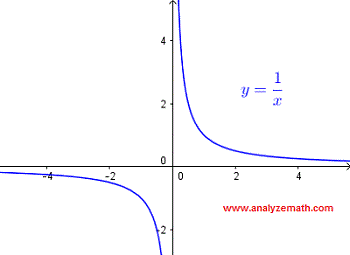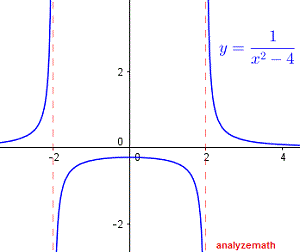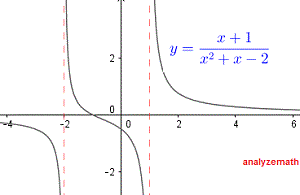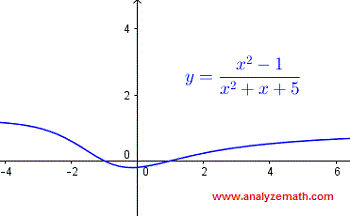
How to find the domain of rational functions? Examples are presented along with detailed solutions and explanations and also graphical interpretation.
We first need to understand that \( \dfrac{1}{x} \) takes real values only if the denominator is not equal to 0. In this case \( x \ne 0 \). This can easily be verified by examining the graph of \( y = \dfrac{1}{x} \) shown below: The graph "exists" for all values of \( x \) except 0.
The domain in interval form is given by: \( (-\infty , 0) \cup (0 , \infty) \)


Example 2
Find the domain of the function \( f(x) = \dfrac{x + 3}{(x - 1)(x + 2)} \).
Solution
The given function takes real values and is therefore real if
\( (x - 1)(x + 2) \ne 0 \)
The expression (x - 1)(x + 2) is not equal to zero if x ? 1 and x ? -2.
In interval form, the domain is given by
\( (-\infty , - 2) \cup (-2 ,1 ) \cup (1 , \infty) \)
Below is shown the graph of \( f \) and we can see that the given function is undefined at x = -2 and x = 1.

Example 3
Find the domain of the function \( f(x) = \dfrac{1}{ {x^2 - 4}} \).
Solution
The given function takes real values and is therefore real if
\( x^2 - 4 \ne 0 \)
Factor x 2 - 4 and rewrite the inequality as
\( (x - 2)(x + 2) \ne 0 \)
The expression (x - 2)(x + 2) is not equal to zero if x ? -2 and x ? 2.
In interval form, the domain is given by
\( (-\infty , - 2) \cup (-2 ,2 ) \cup (2 , \infty) \)
Below is shown the graph of \( f \) and we can see that the given function is undefined at x = -2 and x = 2.

Example 4
Find the domain of the function \( f(x) = \dfrac{x + 1}{x^2 + x - 2} \).
Solution
The given function takes real values and is therefore real if
\( x^2 + x - 2 \ne 0 \)
Factor x 2 + x - 2 and rewrite the inequality as
\( (x - 1)(x + 2) \ne 0 \)
The expression (x - 1)(x + 2) is not equal to zero if x ? 1 and x ? - 2.
In interval form, the domain is given by
\( (-\infty , - 2) \cup (-2 ,1 ) \cup (1 , \infty) \)
Below is shown the graph of \( f \) and we can see that the given function is undefined at x = -2 and x = 1.

Example 5
Find the domain of the function \( f(x) = \dfrac{x^2 - 1}{x^2 + x + 5} \).
Solution
The given function takes real values and is therefore real if
\( x^2 + x + 5 \ne 0 \)
The expression x 2 + x + 5 cannot be factored over the reals. We therefore need to solve the quadratic equation using the discriminant \( \Delta \).
\( x^2 + x + 5 = 0 \)
\( \Delta = b^2 - 4 a c = (1)^2 - 4(1)(5) = -19 \)
The discriminant is negative and therefore no real value of x makes the expression x 2 + x + 5 equal to zero. The domain is the set of all real numbers
In interval form, the domain is given by
\( (-\infty , \infty) \)
Below is shown the graph of \( f \) and we can see that it defined for all values of x real.

Domain and Range
Rational Functions
Rational Expressions and Their Domain
Middle School Maths (Grades 6, 7, 8, 9) - Free Questions and Problems With Answers
High School Maths (Grades 10, 11 and 12) - Free Questions and Problems With Answers